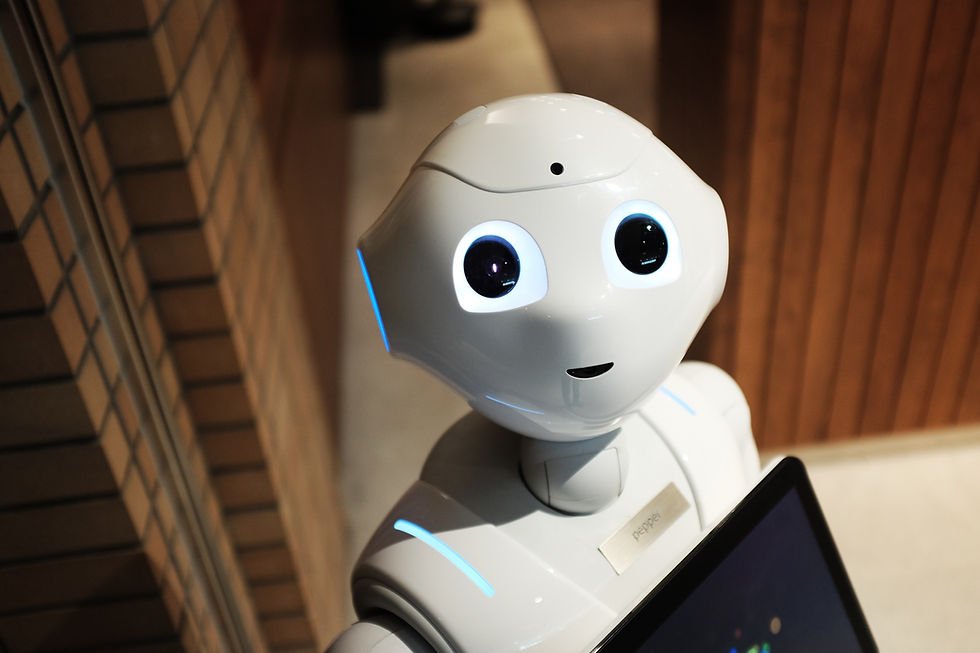Chatbots for Therapy: The Rest of the Story
- Lorena Buzatu

- Oct 21
- 4 min read
Can AI replace human therapy?
It’s a question that keeps surfacing in conversations about mental health. More people are now turning to AI models like ChatGPT, Gemini, or Pi to “talk things through”.
These tools offer an accessible and non-judgemental space to express feelings and explore thoughts. They are available anytime, respond instantly, and never seem impatient. For many people, that feels like progress.
Even as a clinical hypnotherapist, I use AI in my work. It helps me brainstorm, reflect, and write more clearly. So yes, AI can be helpful, but it only tells part of the story of how healing happens.

Why AI Feels Like a Therapist
Why do people feel understood by chatbots?
Because AI is designed to reflect your words back to you in a coherent, empathetic way. It remembers context, affirms your ideas, and rarely disagrees.
That can feel deeply validating, especially when you’re struggling to articulate emotions.
But this is where the first limitation appears.
AI works through pattern recognition, not human understanding. It doesn’t feel your sadness or sense your hesitation. It mirrors the emotional tone in your words, but it doesn’t share the experience behind them.
Therapy, on the other hand, involves real resonance: a human nervous system attuning to another. That connection is more than empathy in language; it’s physiological, embodied, and transformative.
Thinking Isn’t Healing
Can AI help me process emotions?
To some extent, yes. Most AI-based mental health tools use a cognitive model. They guide users to analyse patterns, reframe beliefs, or identify unhelpful thoughts.
That approach has value; it’s rooted in Cognitive Behavioural Therapy (CBT), which has decades of evidence behind it. But human healing rarely stops at the cognitive level.
You can understand your anxiety perfectly and still feel it tightening your chest. You can describe your trauma clearly and still feel your heart race.
Because the mind may understand, but the body still remembers.
The Role of the Body in Healing
Why can’t logic fix emotional pain?
Because emotions are not stored only in the brain. They live in the body: in breath, tension, posture, and sensation.
A chatbot can tell you you’re safe, but your nervous system might not believe it. That’s where modalities like hypnotherapy work differently.
In clinical hypnotherapy, we communicate directly with the unconscious mind. Through focused states of awareness, clients can access the deeper emotional patterns that shape behaviour. This work bypasses intellectual defences and speaks to the part of the mind that truly holds experience.
AI cannot reach that layer. It can process information, but it cannot facilitate integration between body, mind, and unconscious awareness.
The Comfort of Agreement
Why do AI conversations feel so smooth?
Because chatbots are programmed to agree with you. They are designed to be helpful, affirming, and emotionally aligned. That can make them feel like the perfect listener, but it also creates an illusion.
Therapy doesn’t always feel smooth. Growth often begins where discomfort appears.
A human therapist might challenge your assumptions, reflect a difficult truth, or draw attention to something you unconsciously avoid.
AI doesn’t do that. It’s trained to please, not provoke.
And without challenge, insight stays safe; it doesn’t transform.
Information Isn’t Intelligence
Is AI really intelligent?
It depends on how we define intelligence. AI can analyse vast amounts of data and respond with astonishing accuracy, but human intelligence involves something deeper: adaptability, emotion, meaning-making, and embodied awareness.
Psychological theories, from Galton’s sensory measures to Gardner’s multiple intelligences, show that intelligence is not just knowledge. It’s also self-reflection, emotional attunement, and creative problem-solving.
AI imitates these abilities without experiencing them. It predicts meaning, but it doesn’t create it.
In therapy, meaning is created through dialogue, silence, and emotional exchange. That’s the territory of the human mind, especially the unconscious. Hypnotherapy works precisely in that space, helping people transform deep-rooted patterns rather than merely understand them.
When AI and Therapy Work Together
Can AI support the therapeutic process?
Yes, when used intentionally.
I often recommend clients use AI as a reflective tool between sessions. They can use it to journal, explore triggers, or find psychoeducational material. It helps them stay engaged with the process outside the therapy room.
But AI should never replace the relational space where safety, regulation, and transformation occur. It’s a supportive tool, not a substitute for presence.
AI helps people think.
Therapy helps people feel and integrate.
A Conscious Future for Healing
AI isn’t going away. The question isn’t whether we should use it, but how.
If we treat it as a companion for self-reflection, it can expand awareness. If we rely on it to replace connection, it risks flattening what makes us human.
Healing begins where thought meets sensation, where insight meets emotion, and where the mind finally allows the body to exhale.
That’s a process that no algorithm can replicate.
So yes, AI can support your journey, but the heart of therapy still beats between two people.
What to Remember
Chatbots can help with reflection but not deep emotional attunement.
Healing involves body, emotion, and unconscious integration.
Hypnotherapy reaches the layers AI cannot.
AI supports reflection, journaling, and learning between sessions.
Conscious integration of AI enriches, rather than replaces, therapy.







Comments